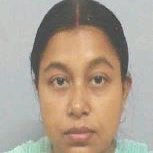
Kuhelika Bera
Work place: Space Application Center (SAC), Indian Space Research Organization (ISRO), Ahmedabad, Gujarat, India
E-mail: kuhelika@sac.isro.gov.in
Website:
Research Interests: Algorithm Design, Data Structures and Algorithms, Computer Architecture and Organization, Interaction Design
Biography
Kuhelika Bera obtained her B.Tech in Radiophysics and Electronics from University of Calcutta. She joined Space Applications Center (ISRO) in 1997 and now working in Sensor Control and Digital Processing Electronics Division. She is involved in the design and development of camera electronics of remote sensing electro optical payloads. Her field of interest is in digital design and signal processing.
Author Articles
Software Implementation of CCSDS Recommended Hyperspectral Lossless Image Compression
By Dharam Shah Kuhelika Bera Sanjay Joshi
DOI: https://doi.org/10.5815/ijigsp.2015.04.04, Pub. Date: 8 Mar. 2015
HyperSpectral Imagers (HySI) are used in the spacecraft or aircrafts to get minute characteristics of target element through capturing image in a large number of narrow and contiguous bands. HySI data represented as data cube with two dimensions representing spatial distribution and third dimension providing band information is huge in volume and challenging task to handle. Hence onboard compression becomes a necessary for optimal usage of onboard storage and downlink bandwidth. CCSDS recommended 123.0-B-1 standard[2] has been released with onboard compression scheme of hyperspectral data. The scheme is based on Fast Lossless algorithm and consists of two main functional blocks namely Predictor and Encoder. Predictor algorithm can be implemented in two modes 'Full Neighborhood Oriented' and 'Reduced Column Oriented'. Encoder algorithm also defines two options 'sample-adaptive' and 'block-adaptive'. We have developed a MATLAB based model implementing the compression scheme with all options defined by the standard. Decompression model is also developed for getting back actual data and end to end verification. Four sets of HySI data (AVIRIS, Hyperion, Chandrayan-1 and FTIS) have been applied as input to the developed model for evaluation of the model. Compression ratio achieved is between 2 to 3 and lossless compression is ensured for each set of data as Mean Square Error (MSE) is zero for all hyperspectral images. Also visual reconstruction of decompressed data matches with original ones. In this paper we have discussed algorithm implementation methodology and results.
[...] Read more.Other Articles
Subscribe to receive issue release notifications and newsletters from MECS Press journals